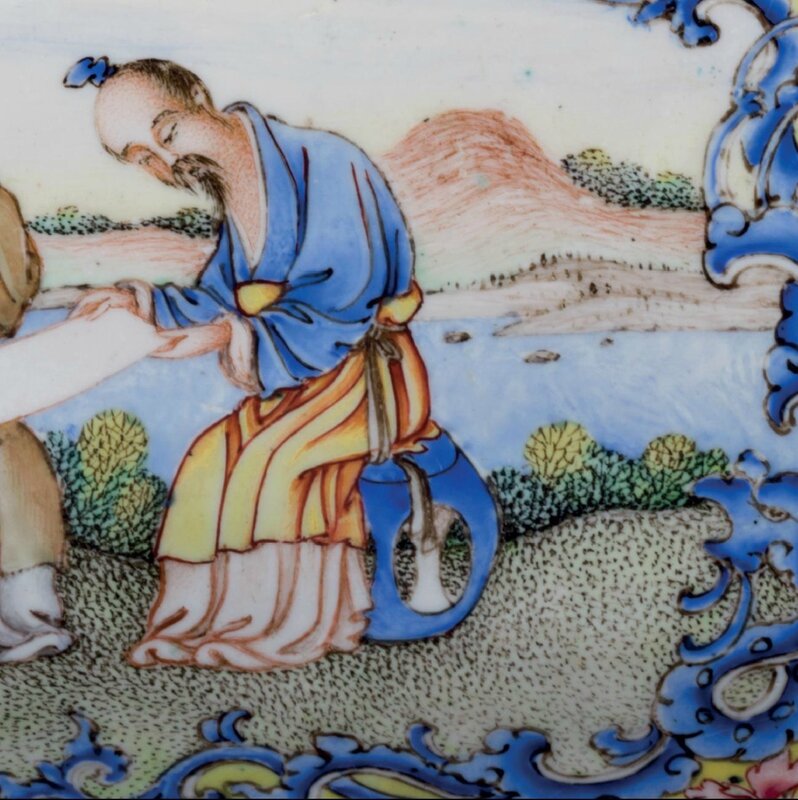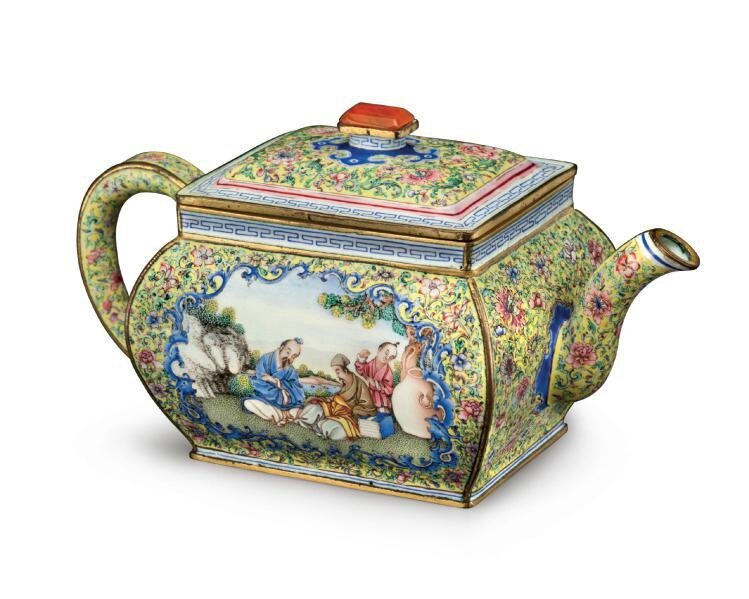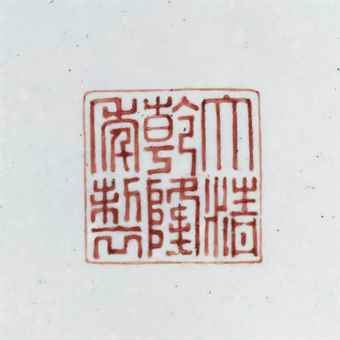An exceptional Imperial painted enamel wine pot and cover, Qianlong six-character seal mark and of the period
An exceptional Imperial painted enamel wine pot and cover, Qianlong six-character seal mark within a square in red enamel and of the period (1736-1795). Estimate $300,000 – $500,000. Photo Christie's Image Ltd 2015.
Each broad side of the faceted bombé body is finely painted with a different scene of scholars, in one, three scholars sit on stools as they examine a painting, and in the other, two scholars sit sleepily on the ground beside an attendant and a large wine jar. Each panel is bordered by blue dragon-scroll and reserved on a dense, foliate scroll-decorated yellow ground repeated on the narrow sides, handle, spout, and cover below a rectangular, carnelian agate finial. 7 in. (17.8 cm.) wide across spout and handle.
Provenance: S. Marchant & Son, London, 2001.
Property from a Private Dallas Collection
Notes: This elegantly-shaped, rectangular-sectioned wine pot is beautifully painted in rich enamel colours in three contrasting, but complementary, styles. The background is painted with elaborate, multi-coloured floral scrolls against an imperial yellow ground. Each of the decorative panels is framed by two confronting archaistic dragons painted in shaded blue and white – their tails and extended wings looping around to meet in the centre of the top and bottom of the frame, respectively. Within the panels the scenes of scholars in garden landscapes have been painted with considerable naturalism making full use of stippling and the extended enamel palette. While each of these three styles of painting is different, they combine to create a harmonious overall design.
A very similar use of styles, colours and themes can be seen on a Qianlong covered bowl in the collection of the National Palace Museum, Taipei, illustrated in Enamel Ware in the Ming and Ch’ing Dynasties, Taipei, 1999, p. 254, no. 135. (Fig. 1) Not only are the background and panel frames similar to those on the current wine pot, both the painting style and the subject of scholars in garden landscape settings within the three panels on the lower part of the Taipei covered bowl are very similar those on the wine pot. Two additional similarities can be seen. One is the red enamel six-character Qianlong seal mark within a single square, which appears on the base of both vessels. The other is the band of blue ruyiheads highlighted with a single white dot which encircles both the finial on the current wine pot and the foot of both lid and base of the covered bowl. While the geometric blue-on-white bands around the edge of the lid and of the mouth and of the lower part of the wine pot, and around the feet and lid edge of the covered bowl are of somewhat different design, it is significant that the bands around the edge of the lid of the wine pot, and the feet of the covered bowl are all painted between narrow red bands.
Fig. 1. A painted enamel covered bowl decorated with landscape scenes and fgures, Qianlong mark and period (1736-1795), in the collection of the National Palace Museum, Taipei, After Enamel Ware in the Ming and Ch’ing Dynasties, Taipei, 1999, p. 254, no. 135.
A similar use of yellow ground with multi-coloured floral scrolls punctuated by panels containing depictions of scholars in garden landscapes can be seen on a Qianlong hand-warmer – also with red enamel six-character Qianlong seal mark within a single square – in the collection of the National Palace Museum, Taipei (illustrated in Enamel Ware in the Ming and Ch’ing Dynasties, op. cit., p. 243, no. 134) although the frames of the panels on the hand-warmer are in red tones and created using abutted S- and C-shaped elements. The use of imperial yellow grounds ornamented with multi-coloured floral scrolls was much admired by the court in the Qianlong reign and can be seen on a number of items in a range of forms preserved in the collections of the Palace Museum, Beijing, and the National Palace Museum, Taipei.
A scene of scholars in a garden setting, similar to the one on the current wine pot, appears on a Qianlong enamelled tea container in the collection of the State Museum of Oriental Art, Moscow (illustrated by Marina Neglinskaya inKitaŸske raspisnìe zmali, Moscow, 1995, cat. 38), although in the case of the Moscow piece, one scholar is playing theqin while another listens and a servant approaches with refreshments. The enamels on the Moscow tea container are less rich than those on the current wine pot and the covered bowl from the National Palace Museum Collection, and the dominant colour in the background is blue rather than yellow, but it is interesting to note that the style was appreciated by the European elite as well as those in China.
Rosemary Scott
International Academic Director, Asian Art
Christie's. FINE CHINESE CERAMICS AND WORKS OF ART, 17 - 18 September 2015, New York, Rockefeller Plaza

/https%3A%2F%2Fprofilepics.canalblog.com%2Fprofilepics%2F1%2F0%2F100183.jpg)
/https%3A%2F%2Fstorage.canalblog.com%2F03%2F02%2F119589%2F96711876_o.jpg)
/https%3A%2F%2Fstorage.canalblog.com%2F11%2F31%2F119589%2F94773502_o.jpg)
/https%3A%2F%2Fstorage.canalblog.com%2F20%2F83%2F119589%2F94772815_o.jpg)
/https%3A%2F%2Fstorage.canalblog.com%2F26%2F72%2F119589%2F75604929_o.jpg)
/https%3A%2F%2Fstorage.canalblog.com%2F59%2F60%2F119589%2F26458628_o.jpg)









/http%3A%2F%2Fstorage.canalblog.com%2F21%2F14%2F119589%2F126394110_o.jpg)
/http%3A%2F%2Fstorage.canalblog.com%2F07%2F95%2F119589%2F125987736_o.jpg)
/http%3A%2F%2Fstorage.canalblog.com%2F04%2F92%2F119589%2F111795530_o.jpg)
/http%3A%2F%2Fstorage.canalblog.com%2F53%2F96%2F119589%2F95446856_o.jpg)